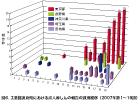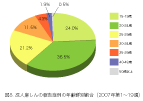|
Measles is caused by measles virus (Family Paramyxoviridae, Genus Morbillivirus) infection.
The disease is spread through airborne transmission via aerosolized droplets, respiratory transmission, or contact transmission and is highly contagious. Typically, the incubation period of measles averages 10 days. The prodromal period characterized by cough, coryza, or conjunctivitis lasts about 3 days, followed by high fever and systemic rash. Other than Koplik spots (enanthem present on mucous), there is no characteristic symptom considered as a pathognomonic for measles that one may not realize being infected by measles virus until rash appears. Together with ability that measles virus can be transmitted one day before rash onset, a patient can infect others without being aware of his/her infection. Especially, the range of social movement of those between in their teens and early thirties are wide, therefore measles can spread faster and broader than that of infants and children. There is no specific treatment for measles and measles is a disease with high hospitalization rate as well as high risk of developing complications such as pneumonia, encephalitis and otitis media.
 |
The National Institute of Infectious Diseases (NIID) collects data, through National Epidemiological Surveillance of Infectious Diseases (NESID) based upon the Infectious Disease Control Law, of measles from approximately 3,000 pediatric sentinels around the country and updates them in the Infectious Disease Weekly Report (IDWR) each week. |
|
Fig.1 Number of cases of measles from 3,000 pediatric sentinels, by weeks (1997 week1-2007 week19)
|
According to the data from NESID, 214 cases (0.071 cases per sentinel) from 26 prefectures were reported in week 19 (May7-13), 2007. This is a huge increase compared to previous week (88 cases, 0.030 cases per sentinel) (Figure 1). Cases reported from Southern Kanto region (Tokyo, Saitama, Kanagawa, and Chiba prefecture) are increasing, and cases are reported from the surrounding region as well as distant regions (Figure 2).
 |
 |
 |
|
Fig.2 Cumulative number of cases of measles from 3,000 pediatric sentinels, by prefectures (week1 through 19,2007)
|
Fig.3 Number of cases of measles from pediatric sentinels in five prefectures, by week (week36,2006-week19, 2007)
|
Fig. 4 Distribution of cases of measles from 3,000 pediatric sentinels, by age (2000-week19, 2007 )
|
The number of cumulative cases reported from the pediatric sentinels between week 1 through 19, 2007 is 691, and already exceeded the total yearly reported cases in 2005 and 2006 (537 and 519 respectively). All of five prefectures with the highest cumulative number of cases in 2007 reported the greatest number of cases in week 19 (Figure 3). There is an increase in the proportion of reported cases among age 10 to 14 years old (33.9%) compared to the previous years, while it is decreasing among age 0 to 4 years old (39.7%) (Figure 4).
In terms of measles among adolescents and adults (15 years old and older), data are collected from approximately 450 hospital sentinels across the country.
 |
The number of cases reported in week 19 was 53 (0.117 cases per sentinel) and was much higher than the previous week (25 cases, 0.055 cases per sentinel) (Figure 5). The number of cases from Tokyo prefecture (19cases) was the biggest and has been continuously increasing since week 15 (April 9~15) (Figure 6). |
|
Fig 5. Number of cases of adult measles from 450 hospital sentinels, by weeks (week14,1999-week19, 2007)
|
The cumulative number of cases reported from the hospital sentinels between week 1 through 19, 2007 is 208, and more than 60% (132 cases) are reported from Southern Kanto region.
 |
 |
 |
|
Fig.6 Number of cases of adult measles from hospital sentinels in five prefectures, by week (week1-19, 2007)
|
Fig.7 Cumulative number of cases of adult measles from 450 hospital sentinels, by prefectures (week1 through 19, 2007)
|
Fig.8 Distribution of cases of adult measles from 450 hospital sentinels, by age (week1 through 19, 2007)
|
However, number of cases reproted from other regions are increasing as well (Figure 7). More than 80% of the cumulative reported cases were under 29 years of age (Figure 8).
In 2007, prefectural and municipal public health institutes isolated measles viruses and/or detected them by PCR measles viruses in 21 cases. Genotype D5 is detected in all 16 viruses tested.
The number of reported case of measles both from pediatric sentinels and hospital sentinels has increased dramatically. Center of epidemic is in Southern Kanto region and cases are continuously increasing, and the similar trend is being observed nationwide. Based on the previous data from NESID, measles cases reported in Japan normally peaks in week 19 in pediatrics and week 20 in adolescents and adults. Thus, in a sense, we may be observing the peak of measles epidemic. However, the epidemic may be expanding from the Southern Kanto region to the surrounding area, so we need to pay close attention to its transition.
Measles has been eradicated from several countries in the world and the World Health Organization Regional Office for the Western Pacific (WPRO) aims to eradicate measles by 2012. Japan must work hard not to be left behind from other countries and should avoid another large measles outbreak like the one in 2001. To meet this goal, it is important to pay attention to the trend in the NESID as well as to conduct rapid and effective intervention to prevent further outbreaks. Once a case of measles is diagnosed in schools or institutional settings, it is desirable to practice accurate intervention immediately. Amid the current outbreak, those who have never been vaccinated or do not have any history of the disease should receive measles vaccine immediately. As infants and young children are most susceptible to measles virus, they are highly recommended to receive the measles vaccination at the age of one year (first dose) and by the entrance of elementary school (second dose).
(Original in Japanese/ http://idsc.nih.go.jp/idwr/index.html)
|
|
|

